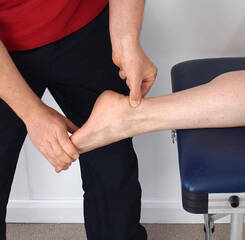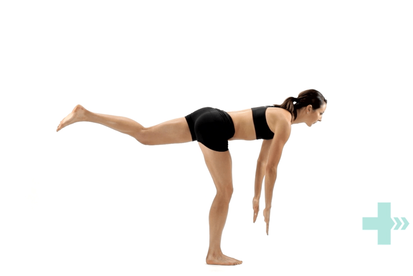|
There is no doubt that the human body can be very resilient. Short of regenerating new limbs, our bodies are capable of recovering from large amounts of damage, including broken bones. With this in mind, many people are happy to let nature take it’s course following an injury, thinking that seeing a physiotherapist will only act to speed up already healing tissues. The speed of recovery, however, is only one measure of healing and despite our body’s incredible capacity for repair, injury repair can be less than straightforward. Here are a few things about injury healing you may not have been aware of... 1. Scar Tissue is more likely to form without treatment.
Scar tissue can cause ongoing pain and stiffness in skin, muscles and ligaments. Physiotherapy can prevent excessive scarring from forming through advice regarding movement, massage and other hands-on treatment. 2. Your ability to sense the position of your body, known as proprioception, is often damaged after an injury and can be retrained. Impaired proprioception is a major factor in re-injury. If you’ve ever heard someone say “my knee/ankle/shoulder still doesn’t feel 100%” then this could be why. The good news is that with a specific exercise program, proprioception can be improved and restored. 3. Once healing has finished, your body may not be exactly the same as before. Following an injury, ligaments may be lax, joints may be stiffer and muscles are almost always weaker. While the pain may be gone, there might still be factors that need to be addressed to prevent more complicated issues in the future. 4. You may have picked up some bad habits while waiting for the injury to heal. While in pain, we often change the way we do things, this can lead to the development of poor movement patterns and muscle imbalances. Even though the pain has gone, these new patterns can remain and create further problems down the road. 5. Injuries don’t always heal completely. On occasion, injuries may not be able to heal completely on their own. The most serious example of this is a fracture that cannot heal if the bone is not kept still enough. Other factors that may prevent an injury from healing include poor circulation, diabetes, insufficient care of the injury and poor nutrition. Your physiotherapist can assess your injury and develop a treatment plan that will both restore you to the best possible function and prevent further injuries.
0 Comments
Many people know the value that physiotherapy brings to their life and some have even been visiting their physiotherapist since quite early in life. However, for those who have never been to see a physiotherapist before, there can be a question mark over exactly what it is that physiotherapists do. In fact, this is one of the most common questions we as physiotherapists are asked. What is the main job of a physiotherapist?
The answer is tricky, because physiotherapists do so much. Primarily, we might be described as pain management experts, as we work to reduce the pain of our patients, from those who have suffered a new injury, to those who have had pain for several years. We first identify the cause of the pain and then provide manual therapy techniques, education and management strategies to help our patient understand, manage and reduce their pain. While pain is usually the first thing that brings patients to see a physiotherapist, this pain has often caused patients to give up activities that they love and can even be getting in the way of everyday tasks. Many of us reduce our activity levels to reduce pain without even realising it. Physiotherapists are able to identify which areas you are struggling in and why this is occurring. By identifying the cause of your symptoms, we can help to get you back to full function. Physiotherapists are able to do this for everyone including elite athletes and those dealing with serious disabilities. In fact, physiotherapists have a role to play at practically every stage of life. Specialised paediatric physiotherapists can assess infants to monitor their motor skills development and as they grow we help them deal with the pains and vulnerabilities of a growing body. Among other things, we can help improve the function of athletes, assist in preventing injuries, help those with pelvic floor dysfunction and work to prevent falls in the elderly. Not just exercises and massage. Physiotherapists offer a range of treatments, from targeted stretches and strengthening exercises, manual therapies, dry needling, lots of advice on activity modification and massage. Physiotherapists are also committed educators and take our role as such seriously. A huge part of recovering from pain and injury comes from understanding what is happening and how to best manage these issues. Rather than create a dependency on their therapist, we aim to empower our patients to improve their health independently as much as possible. Physiotherapists aim to improve your quality of life and remove any barriers to full participation, whether these barriers are due to pain, weakness or stiffness. Ankle sprains are extremely common, however this doesn’t make them easy to cope with when they happen to you. If you’ve ever spent two weeks hobbling around on crutches after a bad twist, you’ll understand just how painful and difficult they can be. What are they?
An ankle sprain refers to an overstretch or tear to the ligaments of the ankle. Commonly, a person will roll their ankle inwards and tear the ligament on the outside. Occasionally, the ankle will twist outwards and the ligaments on the inside of the ankle are torn and even less commonly, the fibres of the ligament that hold the two bones of the lower leg together can tear (this is a "high ankle sprain"). A sprained ankle will usually be painful, swollen, bruised, difficult to walk on and in some cases unstable. How does it happen? Ankle sprains can occur from something as simple as putting weight onto your leg when you think your foot is flat even though it’s not. The most typical pattern is of a person jumping and landing on the outside of their foot or simply slipping and twisting their ankle. A sprained or twisted ankle is one of the most common injuries presented to hospital emergency departments around the world. A medical or health professional should assess any ankle sprain. However, there are some guidelines to help decide if a sprained ankle needs an X-ray... 1. You are unable to put weight on the ankle immediately after the injury. 2. You are unable to take more than 4 steps immediately after the injury. 3. You have pain on the bony edges of the outer foot and ankle. How long do sprains take to heal? Depending on the severity of the tear, from one to six weeks. Your physiotherapist is able to help with recovery and ensure nothing slows down the healing process. Following any injury, joints may remain a little stiff and lose strength and control. Even though the injured tissues have healed, the ankle doesn’t move quite the way it used to. This means that your risk of twisting it again is higher than before the injury. How can physiotherapy help? Correct rehabilitation can help to speed up your recovery and prevent recurring injuries. As well as providing support to the unstable ankle, your physiotherapist will help you to strengthen any weak muscles and restore balance and control through exercise. They are also able to correct any abnormal movement of the joint following the injury. An essential component of physiotherapy treatment is your home exercise program. All physiotherapists know that patients who complete their exercises will have better outcomes from their treatment, however it can be difficult to find time to complete them. Here are a few tips that can help you to fit your exercises into your weekly routine. Plan when to complete them
Making a plan might sound simple, but the expression 'failing to plan is planning to fail' has some truth to it. Physiotherapy exercises are specifically targeted towards weak and tight muscles. The exercises are likely to be a little difficult and uncomfortable. Setting a particular time aside in advance to complete them can help you overcome any resistance to getting them done. Ask your physio to prioritise them Your physiotherapist might give you a combination of exercises to complete. If you're struggling to find time to complete them all, ask your physiotherapist to rank the exercises in order of importance, this can help you to make sure you complete the most important ones when you are short of time. Set triggers as reminders You can use small every day tasks as reminders to remind you to complete your exercises. Some examples include boiling the kettle, brushing your teeth or as a final task before getting into bed. Use positive reinforcement Combining a task you don't enjoy with one that you do is a great way to motivate yourself. You can either pair your exercises with something you love such as watching an episode of your favourite tv show or give yourself a reward once they are completed. Either way, the more positive associations you make with completing your home exercise program, the less barriers you make to completing them! Want more tips? Ask your physiotherapist for their top tips and tricks for fitting your exercise program into your day. Seeing a physiotherapist is an important investment in your health and recovery from pain or injury. Here are a few tips to help get the best outcomes from your treatment sessions... 1. Know what your goals are and ask questions.
If you are clear on what you hope to achieve through physiotherapy, this can help you and your therapist to work together to direct treatment towards these goals. Understanding your condition also plays an important part in recovery, it means that you can make better choices to protect your body and and allow it to heal, and you will know better how to prevent future injuries. Before each treatment, it can help to take a few moments mentally to prepare some questions and consider what your short and long-term goals might be. 2. Do your exercises. Targeted home exercises are almost always an essential part of your recovery as they help your body to support itself through healing and recovery. Exercising is an important way to help correct biomechanical imbalances and reduce excess stress on body structures, as well as helping tissues to strengthen as they recover. 3. Follow your therapist's recommendations. Throughout your recovery, your therapist will guide you as to which activities you should avoid and how much rest to take. Return to sport and activity should be gradual, so as not to stress the body too much too soon when it is still healing. Rest is just as important a part of recovery as strengthening. Following the advice given by your therapist can ensure that you don't injure yourself again and that you get the most out of your body. 4. Be patient with your progress. It can be frustrating waiting for your body to heal. Returning to sport too early or giving up on treatment are common mistakes that lead to further injury or impaired healing. Recovery takes time, a general rule is often that the longer a condition has been present, the longer it will take to resolve. If there is a part of your condition or injury that you are struggling to understand, be sure to seek clarification with your physiotherapist. Two-way communication is key. Many people already know the value that physiotherapy brings to their life, they may have had a physiotherapist with them through the highs and lows of injury and recovery more than once! However, for those who have never been to see a physiotherapist before, there can be a question mark over exactly what it is that physiotherapists do. What is it that physiotherapists do?
The answer is tricky because physiotherapists do so much. We might be described as pain management experts, as we work to reduce the pain of our clients, from those who have suffered a new injury to those who have had pain for several years. We first identify the cause of the pain and then provide manual therapy techniques, education, exercise and self-management strategies to help our patients understand, manage and reduce their symptoms. The pain or injury that motivates people to come and see us has often made them give up activities or sports that they love and can even be getting in the way of everyday tasks. By identifying the cause of your symptoms, we can help to get you back to full function. Physiotherapists are able to do this for people at all activity levels, including the general public, elite athletes and those dealing with serious disabilities. In fact, physiotherapists have a role to play at practically every stage of life. We can assess infants to monitor their motor skills development and as they grow we help them deal with the pains and vulnerabilities of a growing body. Among other things, we can help to prevent injuries, improve pelvic floor dysfunction and work to prevent falls in the elderly. Not just exercises and massage. Physiotherapists offer a range of treatments, from self-management strategies, stretches, manual therapies, dry needling, exercises and massage, to name a few. A huge part of recovering from pain and injury comes from understanding what is happening to you and how to best manage your issues. Rather than create a dependency on your therapist, we aim to empower our patients to improve their health independently as much as possible as well. A physiotherapist's primary goal is to improve your quality of life and remove any barriers to full function and participation in whatever you desire, whether these barriers are due to pain, weakness or stiffness. The knees function as hinges, allowing your legs to swing forwards and backwards smoothly as you walk, kick and run. The knee cap (the patella) sits at the front of the knee and has a variety of functions, including guiding the muscles that straighten the knee, protecting the knee joint and absorbing forces when the knee is bent. When something goes wrong and the patella doesn’t glide up and down smoothly, the soft tissue between the kneecap and the knee can become irritated, causing pain. This is called patellofemoral pain syndrome (PFPS), sometimes also referred to as PFJ syndrome, patella maltracking or runner's knee. Pain is usually felt on the inside of the kneecap when running, squatting, jumping, bending, using stairs or hopping. Sitting for long periods of time or keeping your knees bent can also result in pain. What Causes It?
The patella sits in a shallow groove at the front of the knee and usually moves up and down as the knee bends and straightens without too much trouble. The quadriceps muscles located at the front of the thigh contract and pull on the kneecap, which then attaches to the shin bone and acts to straighten the knee. If one side of the quadriceps is stronger or tighter than the other, it can cause the kneecap to pull more to one side and over time become irritated. The cause of muscle imbalance or weakness can be varied. In general, the outer muscles of the thigh tend to be stronger and tighter than the inner muscles. If you have poor posture and hip position, this can cause the outer muscles to work harder and the inside muscles to become weaker. Lack of arch support in your feet or a physical anomaly of the knees can also contribute to this condition. How Can Physiotherapy Help? Diagnosing patellofemoral pain syndrome correctly is important because pain on the inside of the knee can also be caused by other injuries, dislocations, inflammation, arthritis and a variety of other less common conditions. With that in mind, it is helpful to know that your physiotherapist can diagnosis PFPS accurately and identify its likely causes. Whether it is due to poor posture, a lack of arch support in your feet, or poor running technique, your physiotherapist will assess the problem and provide a specific treatment program to best approach your condition. PFPS usually responds well to biomechanical analysis and correction of any muscular weakness and imbalance. Having the correct shoes and orthotics can also make a huge difference. There are some short-term treatments, such as patella taping, dry needling, massage, trigger point therapy and ultrasound, which may help alleviate symptoms quickly and keep you active while you address the other factors contributing to your pain. In the rare case that your condition is not helped by physiotherapy, surgery may be considered as a last resort. For more information, please ask your physiotherapist. There is no doubt that the human body can be resilient. The body is capable of recovering from amazing amounts of damage, including broken bones. Perhaps because of this, some people feel that physiotherapy treatment can only speed up recovery and if they are not elite athletes then simply letting nature take its course is the best, most cost-effective choice for them. Speed of recovery, however, is only one small measure of physiotherapy success and fails to fully represent how important proper treatment is. Here are a few things about injury healing you may not have been aware of. 1. Scar Tissue is more likely to form without treatment.
Scar tissue can cause ongoing pain and stiffness in your tissues. Physiotherapy can prevent excess scarring through advice regarding movement, massage and other hands-on treatment. 2. Your ability to sense the position of your body, known as proprioception, is often damaged after an injury and can be retrained. Impaired proprioception is a major factor in reinjury. If you’ve ever heard someone say “my knee/ankle/shoulder still doesn’t feel 100%” then this could be why. Physiotherapy treatment will aim to restore proprioception as a part of your rehabilitation. 3. Once healing has finished, your body may not be quite the same as before. Injured ligaments may be weaker, damaged muscles and joints may be stiffer and tighter. While the original pain may resolve, there may still be some residual issues that need to be addressed to prevent reinjury. 4. You may have picked up some bad habits while waiting for the injury to heal. While in pain we often change the way we do things, which can lead to the development of poor movement patterns and muscle imbalances. Even though the pain has gone, these new patterns can persist and create further problems down the road. 5. Injuries don’t always heal completely. On occasion, circumstances may prevent an injury from healing fully. The most serious example of this would be a fracture that cannot heal if the bone is not kept still enough. Other factors that may prevent an injury from healing include poor circulation, diabetes, insufficient care of the injury and poor nutrition. Your physiotherapist can guide you on the best path to a more complete recovery from any injury. Your physiotherapist has a wide variety of skills and can help you with so much more than just pain and injury. Here are a few reasons to visit your physiotherapist that can keep you healthy and pain-free, before injury strikes... Stiffness and Inflexibility
Almost all of us have experienced pain and stiffness after a day of increased or unaccustomed exercise. This kind of stiffness usually wears off quickly and is referred to as DOMS (delayed onset muscles soreness). However, if you find yourself feeling stiff for more extended periods, or even most of the time – it might be time to see a physio. There are many different causes of stiffness and inflexibility. By far the most common is lack of movement. Our joints and muscles both lose flexibility if not moved through their range regularly. Muscle stiffness can feel like a tightness with a bouncy feeling of restriction, and joint stiffness can create a harder ‘blocked’ feeling when you try to move. When it comes to stiffness that evolves from lack of movement, you may not even notice that you have lost range, as it can be easy to adapt your movements to compensate. Your physiotherapist can help you to identify where you have areas of inflexibility and help you to exercise, stretch and mobilise your joints to get them back to a healthy range. Disease processes such as osteoarthritis and rheumatoid arthritis can also cause prolonged stiffness, and your physiotherapist is well equipped to help you deal with these conditions. Reduced Strength or Weakness There are many possible reasons for weakness in the body, from generalised disuse, weakness in one muscle group following an injury, neurological weakness or structural weakness of joint following a ligament tear. Musculoskeletal deficiency of any kind can predispose you to future injuries and are difficult to resolve without targeted exercises. Your physio can determine the cause of your weakness and prescibe the best treatment to restore your strength. Reduced Balance Keeping your balance is a complicated process and your body works hard to make sure you stay on your feet. Humans have a small base of support for our height and we use all our senses together to determine which movements we should make to stay upright, including our visual, vestibular, muscular and sensory systems. As balance is essential for walking, if one system that supports our balance begins to weaken, the others will quickly compensate, so you may not notice that your balance has worsened until you fall or trip over unexpectedly. As a general rule balance deteriorates as we get older, but this doesn't mean that falling should be an inevitable part of aging. Actively working to maintain or improve your balance can have a significant effect on your quality of life and confidence in getting around. Your physiotherapist is able to test all aspects of your balance and provide effective rehabilitation to help keep you on your feet. Physiotherapy treatment can be life changing, helping you recover from traumatic injuries, acute or chronic pain and get you on the road to your best performance levels. Here are a few tips to make sure you get the most out of your physiotherapy treatment. 1. Ask your physio questions about your injury
Understanding your condition and how to best manage it is one of the most important factors for a successful recovery. Effective therapists allow time for you to ask questions in a non-judgmental environment. There are no stupid questions, if you don’t understand what is happening in your own body it is harder to follow advice and stick to your program. This can also help you to cope with pain and feel less helpless in your recovery. 2. Follow your physio’s advice and do your exercises Home exercises are a key part of your recovery, especially when treatment times are limited. Try to stick to your exercise program as seriously as you would a medicine schedule. It is also important to ensure that you are doing your exercises correctly at home. Don’t be afraid to double and triple check your technique during your appointments. Your therapist will also provide you with advice regarding activities to avoid, how to stretch, when to rest and how to avoid further injury. If you’re not sure about something, ask your therapist to write it down for you. 3. Notice your improvements Nothing can be more disheartening than feeling like the appointments and exercises you’re diligently attending to are making no difference. As therapists, we make regular measurements to track your improvement and know that while your symptoms might be lingering, you are actually moving more and increasing stress on your body as you recover. Set your own measurements to help you track your recovery. This can help you stick to treatment and feel more positive as you complete your recovery journey. 4. Set goals and work with your physio to meet these. The goals of recovery are different for everyone. Some of us want to be able to reach peak performance, such as running a marathon. For others, just getting through the day with a little less pain would be a huge success. Know your own goals and take the time to discuss this with your therapist, who will guide your treatment to help you meet these milestones. Our physiotherapists at The Physio Nook are happy to discuss your condition with you and share their tips to help you stay pain-free. |
Categories
All
|











